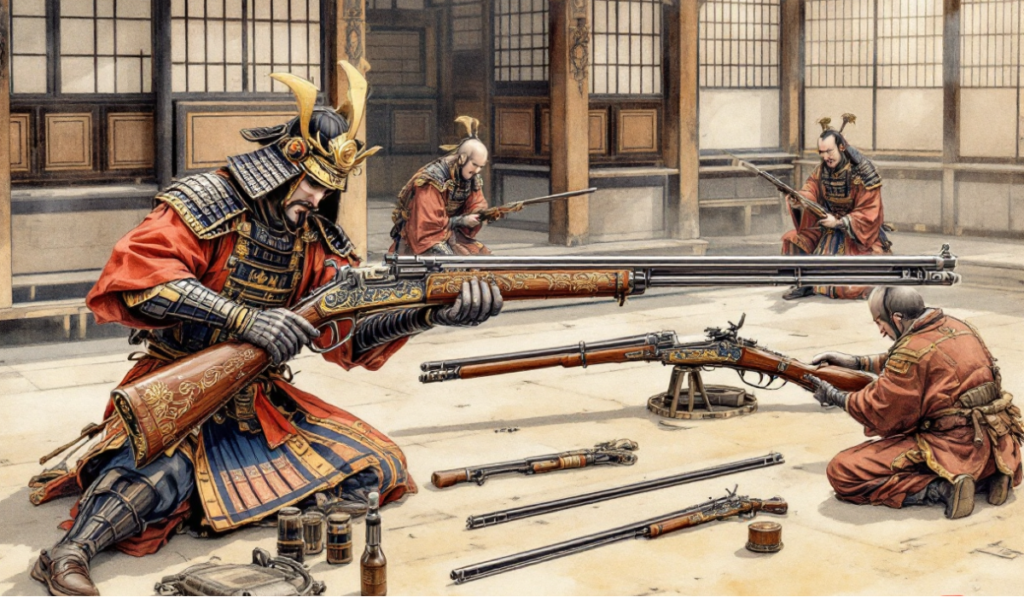How Feudal Japan Transformed a Foreign Innovation into a Cultural and Military Icon
The arrival of matchlock firearms in 16th-century Japan marked a turning point in the archipelago’s military history. While the Portuguese introduced the technology in 1543, the Japanese didn’t merely adopt it—they reinvented it. Through relentless innovation, craftsmanship, and tactical creativity, Japan transformed the European arquebus into a weapon uniquely suited to its terrain, culture, and warfare. Here’s how they did it.
1. From Tanegashima to Mass Production: Mastering the Basics
The Portuguese matchlock first landed on Tanegashima Island, where local swordsmiths reverse-engineered the design. Early challenges included replicating the screw-breech mechanism, a technique previously unknown in Japan. With help from a Portuguese blacksmith, they overcame this hurdle, and within a decade, Japan was producing matchlocks at an astonishing scale—reportedly over 300,000 by the 1570s 310.
Key Innovations:
- Localized Craftsmanship: Production hubs like Sakai and Kunitomo emerged, specializing in high-quality barrels and mechanisms. Artisans refined the lock mechanism for reliability, using brass or iron components resistant to corrosion 910.
- Standardization: Guns were categorized by caliber (measured in momme, a unit of bullet weight) and purpose, such as the ban-zutsu for infantry and samurai-zutsu for elite warriors 35.
2. Tactical Revolution: Overcoming Limitations
Early matchlocks were slow, rain-prone, and inaccurate. The Japanese tackled these flaws head-on:
- Weatherproofing: Lacquered wooden boxes shielded the firing mechanism during rain, while wax-coated paper cartridges (hayago) kept gunpowder dry. These innovations allowed use in harsh conditions 310.
- Rapid Reloading: The hayago cartridge system—pre-measured powder, wadding, and bullet—cut reloading time to 20 seconds per shot, rivaling European efficiency 59.
- Night Combat: Strings with measured knots were tied to barrels to maintain firing angles in darkness, enabling precision without visual aiming 710.
3. Battlefield Dominance: Tactics That Changed Warfare
The matchlock’s true power emerged through strategic deployment:
- Volley Fire: At the Battle of Nagashino (1575), Oda Nobunaga’s gunners used staggered firing lines to create continuous barrages. While later accounts exaggerated the scale (only ~1,500 gunners were present), the psychological impact on cavalry charges was undeniable 26.
- Siege Warfare: Larger-caliber o-zutsu “hand cannons” smashed castle gates, while hazama-zutsu long-range guns defended fortifications 310.
- Combined Arms: Archers often supported gunners, providing covering fire during reloads. Bows remained lethal, causing more battlefield casualties than guns even in the Edo period 27.
4. Cultural Integration: Beyond the Battlefield
Matchlocks became embedded in Japanese society:
- Martial Art (Hōjutsu): Schools like the Kishu-ryū formalized gunnery into a discipline emphasizing precision and discipline, akin to archery or swordsmanship 79.
- Status Symbols: Elaborately decorated guns, often gifted to daimyō, featured gold inlays and family crests. Samurai used pistols (tan-zutsu) as symbols of authority 510.
- Hunting and Rituals: During the peaceful Edo era, matchlocks were repurposed for hunting deer and boar. Farmers even used them to scare off crop-raiding animals 710.
5. Debunking Myths: The Edo Period Decline
Contrary to the myth that Japan “abandoned guns,” production continued under the Tokugawa shogunate. However, with fewer large-scale wars, firearms shifted to ceremonial and practical roles:
- Gunsmiths Thrived: Over 200 workshops operated by the 19th century, preserving traditional techniques 210.
- Technological Stagnation: Isolation policies limited exposure to flintlocks and percussion caps, but experimentation persisted. For example, Kunitomo Ikkansai developed air rifles in the 1820s 79.
Legacy: From Satsuma to Modern Reenactments
Even after Commodore Perry’s arrival in 1853 forced Japan to modernize, matchlocks saw final use in the 1877 Satsuma Rebellion. Today, they’re celebrated in festivals and martial arts, with enthusiasts replicating historic firing drills 1012.
Why Japan’s Matchlock Story Matters
Japan’s matchlock evolution wasn’t just about better guns—it reflected a society adept at blending foreign ideas with local needs. From weatherproofing to volley tactics, these innovations underscore a broader lesson: adaptation, not mere adoption, drives technological mastery.
For further reading, explore historical accounts from the Battle of Nagashino or join discussions in Japanese matchlock enthusiast groups.
FAQs About How Did Japanese Improve and Change Matchlock Guns:
Q1: What were the key innovations in Japanese matchlock guns?
- Japanese matchlock guns, known as “tanegashima,” were improved by adding features such as enhanced barrel lengths, stronger gunpowder, and better craftsmanship in manufacturing to increase range and accuracy.
Q2: How did Japanese matchlock guns impact their military during the Sengoku period?
- The introduction of matchlock guns in the 16th century significantly changed battlefield tactics in Japan, allowing infantry units to deliver powerful volleys and reshaping the structure of feudal warfare.
Q3: Did the Japanese develop their own unique firing mechanisms for matchlock guns?
- Yes, the Japanese developed unique firing mechanisms, such as the “matchlock” system, where a burning wick would ignite the powder charge when pulled by the trigger, contributing to their distinctive design.
Q4: How did the Portuguese influence the development of Japanese matchlock guns?
- Portuguese traders introduced the matchlock gun to Japan in the mid-16th century, leading to significant adaptation and improvement by Japanese gunsmiths, who enhanced its effectiveness for local use.
Q5: How did Japanese matchlock guns evolve over time?
- Over time, Japanese matchlock guns were modified with improvements like stronger metal parts, more reliable firing mechanisms, and better accuracy, making them a crucial tool in Japan’s military campaigns.

